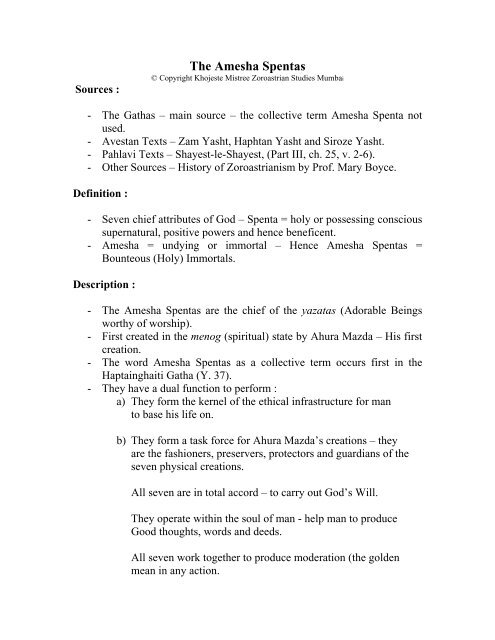Create successful ePaper yourself
Turn your PDF publications into a flip-book with our unique Google optimized e-Paper software.
Sources :<br />
<strong>The</strong> <strong>Amesha</strong> <strong>Spentas</strong><br />
© Copyright Khojeste Mistree Zoroastrian Studies Mumbai<br />
- <strong>The</strong> Gathas – main source – the collective term <strong>Amesha</strong> Spenta not<br />
used.<br />
- Avestan Texts – Zam Yasht, Haphtan Yasht and Siroze Yasht.<br />
- Pahlavi Texts – Shayest-le-Shayest, (Part III, ch. 25, v. 2-6).<br />
- Other Sources – History of Zoroastrianism by Prof. Mary Boyce.<br />
Definition :<br />
- Seven chief attributes of God – Spenta = holy or possessing conscious<br />
supernatural, positive powers and hence beneficent.<br />
- <strong>Amesha</strong> = undying or immortal – Hence <strong>Amesha</strong> <strong>Spentas</strong> =<br />
Bounteous (Holy) Immortals.<br />
Description :<br />
- <strong>The</strong> <strong>Amesha</strong> <strong>Spentas</strong> are the chief of the yazatas (Adorable Beings<br />
worthy of worship).<br />
- First created in the menog (spiritual) state by Ahura Mazda – His first<br />
creation.<br />
- <strong>The</strong> word <strong>Amesha</strong> <strong>Spentas</strong> as a collective term occurs first in the<br />
Haptainghaiti Gatha (Y. 37).<br />
- <strong>The</strong>y have a dual function to perform :<br />
a) <strong>The</strong>y form the kernel of the ethical infrastructure for man<br />
to base his life on.<br />
b) <strong>The</strong>y form a task force for Ahura Mazda’s creations – they<br />
are the fashioners, preservers, protectors and guardians of the<br />
seven physical creations.<br />
All seven are in total accord – to carry out God’s Will.<br />
<strong>The</strong>y operate within the soul of man - help man to produce<br />
Good thoughts, words and deeds.<br />
All seven work together to produce moderation (the golden<br />
mean in any action.
Man should recognize and respect the <strong>Amesha</strong> <strong>Spentas</strong> and by<br />
listening to them integrate them in his daily life, carrying out his<br />
actions in accordance with their commands (Y. 50, v. 4; Y. 30, v. 9).<br />
Application of the <strong>Amesha</strong> <strong>Spentas</strong> in one’s daily actions:-<br />
Vohu Manah (the Good Mind) receives the true motivation from<br />
Spenta Mainyu (the Holy Spirit) and places God’s Will into operation<br />
in accordance with Asha Vahishta (the Best Order and Truth) – By<br />
exercising Khshathra Vairya (authority and moral conviction) and<br />
balancing it with Spenta Armaity (receptivity – devotion to the task),<br />
the action is carried out with Haurvetat (Perfection) – Such a deed<br />
then belongs to Ameretat (Immortality) as a small frasho.kereti<br />
(bringing about perfection through righteousness) and – when man<br />
bases his action on the dictates of the <strong>Amesha</strong> <strong>Spentas</strong> and then<br />
reflects it to his conscience (guide to God’s Will) to find out the<br />
motivation (God’s Will), he performs a real good deed.<br />
- Spiritual Reality becomes real through :-<br />
a) Path of conscious knowledge – awareness and intellect (head)<br />
b) And path of devotion (heart) which manifests through:<br />
i) Rituals which existentialize doctrine, giving experiential<br />
qualities to concepts like Vohu Manah and Asha<br />
Vahishta.<br />
ii) By integrating the <strong>Amesha</strong> <strong>Spentas</strong> in daily life.<br />
iii) Consciously balancing the ethical infrastructure with<br />
conscience to get the true motivation (God’s Will).<br />
- <strong>The</strong> <strong>Amesha</strong> <strong>Spentas</strong> are the strongest weapons within man to fight<br />
evil (Y. 34, v. 11; History of Zoroastrianism by M. Boyce, Vol. 1, p.<br />
220).<br />
- <strong>The</strong> man who recognizes the unity which lies in the ethical abstract<br />
world and the physical tangible world of creations, and bases his life<br />
on it by heeding the <strong>Amesha</strong> Spenta ethical infrastructure and taking<br />
2
care of the creations, will never go to hell (Sh-n-Sh. Part III, Ch. 25,<br />
para 2-6).<br />
- <strong>The</strong> <strong>Amesha</strong> <strong>Spentas</strong> will restore the world at frasho.kereti (Zam<br />
Yasht, S.B.E. Series, vol. 23, p. 290, para 15-20).<br />
- <strong>The</strong> <strong>Amesha</strong> Senta structure is the heart of the doctrine on which<br />
Zoroastrians base their lives.<br />
- <strong>The</strong> Creation Infrastructure of the <strong>Amesha</strong> <strong>Spentas</strong> is different in<br />
order from the ethical infrastructure :-<br />
No. Creation No. Ethical Infrastructure<br />
Infrastructure<br />
1 st Sky 4 th Khshathra Vairya<br />
(Sovereign Kingdom)<br />
2 nd Water 6 th Haurvetat (Perfection)<br />
3 rd Earth 5 th Spenta Armaity (Piety /<br />
Devotion)<br />
4 th Plant 7 th Ameretat (Immortality)<br />
5 th Animal 2 nd Vohu Manah<br />
(Good Mind)<br />
6 th Man 1 st Spenta Mainyu<br />
(Holy Spirit)<br />
7 th Fire 3 rd Asha Vahishta (Order /<br />
Truth / Righteousness)<br />
- <strong>The</strong> ethical infrastructure given by Zarathushtra – Creation<br />
infrastructure worked out late by learned priests who linked the<br />
appropriate cration to its ethical couterpart.<br />
- <strong>The</strong> <strong>Amesha</strong> <strong>Spentas</strong> usually linked in terms of concept :<br />
3
- Triadic principles of Spenta Mainyu, Vohu Manah and Asha Vahishta<br />
(Y. 43, v. 2).<br />
- Combinationof Vohu Manah and Asha Vahishta (Y. 43, v. 2 & 121;<br />
Y. 50, v. 4; Y.28 v.11).<br />
- Coupling of Haurvetat and Ameretat (Y. 31, v. 6; Y 34, v. 11; Y. 45,<br />
v. 5)<br />
- <strong>The</strong> first four <strong>Amesha</strong> <strong>Spentas</strong> are active as balanced to the lat three<br />
which are passive attributes.<br />
- <strong>The</strong> balance between the active and passive principles is stressed for<br />
moderation :-<br />
o Balance between Vohu Manah (active) and Spenta Mainyu<br />
(passive) (Y. 34, v. 10; Y48, v. 5).<br />
o Balance between Khshathra Vairya and Spenta Armaity (Y. 31,<br />
v. 4; Y. 44, v. 7; Y. 51, v. 21).<br />
o Balance between Asha Vahishta and Spenta Armaity (Y. 33, v.<br />
13; Y. 49, v. 5; Y. 44, v. 6; Y. 43, v. 9).<br />
o Combined balance between Asha vahishta, Khshathra vairya<br />
and Spenta Armaity (Y. 44, v. 6).<br />
Individual <strong>Amesha</strong> <strong>Spentas</strong> :<br />
Spenta Mainyu : (Holy Spirit of God) (Y. 28, v. 11; Y. 43, v. 2; Y. 47, v.2).<br />
- Purely Zoroastrian concept introduced by Zarathushtra.<br />
- Responsible for creation of man – the 6 th creation.<br />
- First in the heptad of the <strong>Amesha</strong> <strong>Spentas</strong>.<br />
- <strong>The</strong> motivating force to carry out God’s Will.<br />
- Ahura Mazda, through His conscious thought first created Spenta<br />
Mainyu which then served as a torch to light the other 6 <strong>Amesha</strong><br />
<strong>Spentas</strong> (Ayadgur-i-Jamaspi).<br />
- Spenta Mainyu is just a step below Ahura Mazda – some scholars<br />
equate the two.<br />
- Guides man in his free will to choose the good from the evil – Man is<br />
the only creation endowed with consciousness to exercise freedom of<br />
4
choice – animals choose and react through instinct alone whereas man<br />
can choose consciously through his mind.<br />
- Man is Ahura Mazda’s finest creation – he alone can carry out God’s<br />
purpose for perfecting this world by ridding it of all evil through<br />
conscious practice of good thoughts, words and deeds.<br />
- Because of this God’s own Holy Spirit was assigned to man as his<br />
fashioner, preserver and protector – Man is made in the image of God<br />
and has His other attributes (<strong>Amesha</strong> <strong>Spentas</strong>) also within him.<br />
- Man has a maximum responsibility towards looking after himself as<br />
well as taking care of the other creations. (Y. 28, v. 11; Y. 43, v. 2; Y.<br />
47, v.2).<br />
Vohu Manah : (Good Mind) (Y. 32, v. 6; Y. 45, v. 9; Y. 50, v.6)<br />
- Purely a Zoroastrian concept introduced by Zarathushtra for the first<br />
time in the history of religion.<br />
- No other religion lays the premium on the good mind the way<br />
Zoroastrianism does.<br />
- Crucial to man to differentiate between good and evil.<br />
- Helps man to consciously discern God’s Plan for the universe and to<br />
implement it.<br />
- Most crucial to carry out good thoughts, words and deeds.<br />
- Vohu Manah is in charge of the 5 th creation – animal.<br />
- Domestic animals like the cow symbolize mildness, benevolence and<br />
beneficial qualities on which man depends – the cow chooses the<br />
herdsman as its master and serves him with good intention.<br />
- At the level of animal consciousness, the cow recognized Ahura<br />
Mazda and asked for deliverance (Y. 29, v. 1) – <strong>The</strong>refore at animal<br />
level, the cow and other domestic animals stand for good, intentions<br />
to serve mankind – hence the link with Vohu Manah. (In pre-<br />
Zoroastrian times, the divinity for the animals was Verethragna<br />
(Bahram) anthropomorphized as a wild boar.<br />
- Vohu Manah is purely Zoroastrian in concept.<br />
- Vohu Manah gives good intelligence, good discernment and the best<br />
vision to recognize and implement God’s Plan for the universe and<br />
helps man to morally and ethically make the correct choice.<br />
- As Vohu Manah is present in man, man has the responsibility to look<br />
after and protect the animal world.<br />
-<br />
5
Asha Vahishta : (Best Order/Truth/Righteousness) (Y. 49, v. 3; Y. 50, v. 6).<br />
- Asha on the physical level is order – essential for life and health<br />
- On the psychological level, this order becomes Truth<br />
- On the spiritual level it is the quintessence of order and truth which is<br />
righteousness.<br />
- By observing order and realizing the truth in it, one leads a life<br />
- Asha regulates the functioning of the universe – responsible for the<br />
harmony prevalent in the creations.<br />
- When man realizes this, this principle and exercises truth for its own<br />
sake, he finds happiness and is in harmony within himself as well as<br />
in harmony with his surroundings.<br />
- God’s Plan is based on the path of Asha – the path to realization of<br />
God as it is pure and undefiled.<br />
- As Asha is uncontaminated and stands for Truth which is the nature of<br />
Ahura Mazda, it is associated with fire which symbolizes truth.<br />
- Hence truth and fire are inter-linked (Y. 43, v. 4 & 9).<br />
- Fire reveals the truth of existence and is the repository of wisdom.<br />
- Intrinsically pure and the nearest to total purity in this relative world<br />
- Pure like truth.<br />
- God is Truth (He Exists) and His essence in existential form is the fire<br />
which is therefore synonymous with Truth.<br />
- Hence Asha Vahishta is the fashioner and protector of the fire, the<br />
seventh creation.<br />
- In pre-Zoroastrian times the concept of Asha was not well developed<br />
- Was seen as Rta<br />
- Zarathushtra developed this concept into a crucial principle to base<br />
one’s life on.<br />
© Copyright Khojeste Mistree Zoroastrian Studies Mumbai<br />
6



